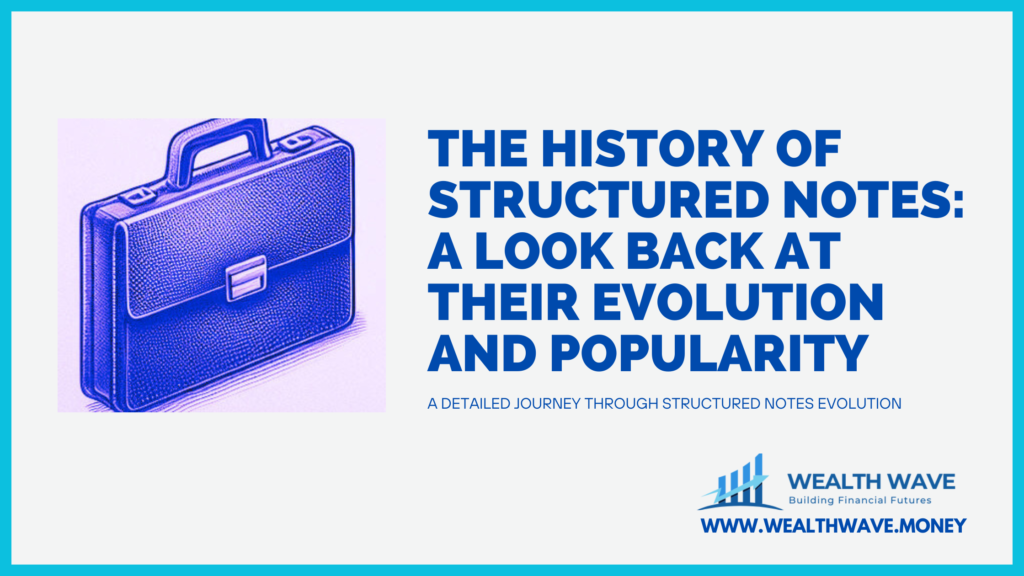Navigating the investment landscape can often feel like wandering through a maze. With an array of choices from stocks and mutual funds to exchange-traded funds, making the right decision for your finances seems challenging.
We understand that feeling all too well. One particular investment vehicle that sparked our curiosity during our deep dive is structured notes. Interestingly, these structured products first carved out their niche in the UK during the early 1990s, blending traditional securities with derivative components to target specific outcomes like growth or risk management.
In this blog post, we’re excited to walk you through the fascinating journey of structured notes. From their inception in the 1980s to their current role in wealth management strategies today, we’ve got it covered.
You’ll gain insights into how they evolved, pivotal moments along their trajectory, and what future direction they might take. If you find investing overwhelming, this piece might just help demystify some aspects for you.
Stay tuned as we explore an intriguing chapter of The History of Structured Notes
Key Takeaways
- Structured notes first appeared in the 1980s in France and the UK. They blend traditional securities with derivatives to manage risk and aim for growth.
- The 2008 financial crisis caused a big drop in markets and led to new rules making structured notes safer for investors. These changes included laws like MIFID and PRIPS.
- Technology changed how we make and manage structured notes, using algorithms for better customization. Digital platforms now let people trade these more easily.
- These investments became popular worldwide, especially in Asia by 2017 with South Korea leading, showing their global appeal.
- Including ESG factors shows a shift to investing that also cares about environmental and social issues, not just profits.
The Origins of Structured Notes
Structured notes first emerged in the 1980s, gaining significant traction in the investment landscape during the 1990s. This period marked a pivotal shift in how investors approached diversification and risk management.
Development in the 1980s
In the 1980s, France and the UK saw the birth of structured products. These financial vehicles blended options, capital gains, interest rates, and dividends to offer investors new ways to achieve potential returns while managing risks.
Our journey in developing these unique investment solutions started with a simple idea: to provide a cushion against market downturns while capturing upswings.
Our teams worked closely with investment banks to craft these first structured notes. We focused on principal protection, aiming to safeguard the investor’s initial capital in volatile markets.
Interest rates played a crucial role as we designed products that could benefit from their fluctuations without exposing investors to unnecessary risks. This period marked a significant step forward in our quest to offer personalized investment opportunities across Europe.
Popularity Surge in the 1990s
After the initial growth in the 1980s, structured products really took off in the 1990s. This decade saw an explosion in their popularity across Asia. Banks and financial institutions started to offer these investment vehicles more widely.
They provided a way for investors to access various markets without directly buying stocks or bonds. Structured products offered solutions that could match different investor needs for risk and return.
Structured products expanded globally, finding a strong foothold in Asia during the 1990s.
This era also marked a shift towards more innovative financial instruments. Investors sought out ways to protect their investments while still seeking good returns. With structured products, they found flexibility and customization not easily available with standard investment funds or direct stock purchases.
The expansion of these products into new markets shows how dynamic and adaptable the financial industry can be.
Key Historical Events Shaping Structured Notes
Structured notes emerged during the 1980s and saw a surge in popularity throughout the 1990s. The impact of the 2008 financial crisis led to significant regulatory changes affecting structured notes.
The 2008 Financial Crisis Impact
The 2008 financial crisis shook the world, and structured notes were no exception. Lehman Brothers, a giant in banking, fell apart. This event sent shockwaves through the stock market and beyond.
Markets tumbled; by 2010, they had fallen by 27%. Investors looked closely at their investments, worried about what might happen next.
We saw fear grip everyone with interests tied to the stock market or debt securities. The collapse of Lehman Brothers made it clear: not all investments were safe. Suddenly, things like creditworthiness and investment advice took on new urgency.
People across the globe reevaluated where they put their money. Our faith in markets and institutions was deeply shaken but also made us wiser about risks associated with various financial products.
Regulatory Changes Following 2008
After the financial upheaval in 2008, we saw governments and regulatory bodies worldwide spring into action to prevent a repeat. In 2013, they introduced new laws like MIFID (Markets in Financial Instruments Directive), PRIPS (Packaged Retail and Insurance-based Investment Products), PD (Prospectus Directive), and RDR (Retail Distribution Review).
These changes had a big impact on how structured notes were distributed. They aimed to make the market safer for investors by improving transparency and ensuring that products were suitable for those investing in them.
New regulations mean better protection for investors.
In 2018, Europe took further steps by implementing PRIIPS and KID (Key Information Document). These initiatives required clearer communication about the risks, rewards, and costs of investment products.
For us, this meant providing our clients with documents that easily explained complex financial instruments like structured notes. It was all about making sure our investors knew exactly what they were getting into—highlighting potential returns as well as the risks involved.
Technological Innovations in Structured Notes
Structured notes have undergone significant technological advancements. Algorithm-based structuring has revolutionized the creation process, while digital platforms have facilitated trading and management.
Algorithm-Based Structuring Introduction
We saw a big change in how we create and manage structured notes thanks to algorithms. These smart computer programs make the process faster and let us tailor things just right for what investors need.
By using these algorithms, we can figure out complex math problems quickly. This means we can match investments perfectly with an investor’s goals.
This shift helped us move away from slow, manual ways of putting together these financial products. Now, we use technology to handle everything with precision. The result? Investors get their hands on structured notes that fit what they’re looking for way better than before.
And because it’s all done with computers, we can do it all much more efficiently.
Digital Platforms Growth for Trading and Management
Digital platforms have transformed how we trade and manage structured notes. With technology advancing, these platforms offer investors easy access to the secondary market, better management of their investment portfolios, and up-to-date insights into market liquidity and yields.
They streamline processes that were once complex and time-consuming. Now, investors can quickly assess the net asset value (NAV) of their investments, making decisions based on accurate data with just a few clicks.
These online platforms also support trading in various financial instruments like exchange-traded funds (ETFs), exchange-traded notes (ETNs), swaps, and futures. This variety gives investors more options to diversify their portfolios beyond traditional assets.
The increase in accessibility has made structured notes more popular among both individual investors and hedge funds looking for correlated assets or hoping to capitalize on rate of return while managing risks efficiently.
Next, let’s explore the expansion into global markets.
Structured Notes’ Global Market Expansion
Structured notes’ reach extended to Asian markets and secured a strong foothold in European countries, propelling new market expansion. Globally, structured notes have gained momentum with evolving investor interest and a solid market performance analysis.
Expansion into Asian Markets
We saw structured notes spread to Asia in the 1990s. This move opened new doors for investors and issuers alike. By 2017, South Korea secured its place as the go-to market for these financial products by issuance volume.
This achievement shows how keen Asian markets became on structured notes.
In 2018, China marked a sales volume of CNY34.5bn in structured products. This figure emphasizes the growing interest and confidence among Chinese investors and financial institutions in leveraging such instruments for diversification and potential gains.
The expansion into Asian markets signifies a crucial shift towards more advanced investment strategies within the region.”
Adoption Across European Countries
In Europe, Switzerland and Germany lead the market for structured products. Their markets have grown the most. This shows their strong interest in these financial tools. Other countries like the Netherlands, Norway, and the UK saw a drop in sales after the credit crisis hit.
The Austrian market is also doing well with an estimated size of €2bn to €2.5bn. This growth across different European countries highlights how investors there are keen on using structured notes to manage risk and aim for returns.
Recent Advancements in Structured Notes
Structured notes have been enhanced by the integration of ESG factors and innovations in risk management strategies. These advancements aim to provide tailored, ever-evolving solutions for investors seeking more than just financial returns.
Integration of ESG Factors
We have seen a shift in how we design structured notes by including ESG factors. This change reflects our commitment to align investments with social and environmental values. By weaving ESG considerations into the investment process, these structured notes aim for both financial returns and positive outcomes for society and the environment.
Our focus on ESG has grown because investors want their money to support sustainable practices. They look for opportunities that match their values while providing gains. This integration offers a way for investments in structured notes to contribute to a better world alongside achieving potential market value enhancements.
We see this as an important step in responsible investing, emphasizing not just profits but also the impact of investment choices on broader issues like climate change, corporate governance, and social equity.
Innovations in Risk Management Strategies
Innovations in risk management strategies have improved structured notes for addressing market conditions and investor needs. These advancements have led to increased popularity among investors looking for alternative investment solutions providing downside protection with potential upside gains.
The adoption of emerging risk management techniques has enhanced the appeal of structured notes for managing risk and improving returns, making them more attractive in today’s evolving investment landscape.
The Regulatory Framework for Structured Notes
The regulatory landscape surrounding structured notes has undergone significant changes in recent years, with influential regulations shaping the industry. Major regulations affecting structured notes include Dodd-Frank and MiFID II.
Compliance with these regulations poses challenges for market participants and requires a deep understanding of their implications on structuring and issuance processes.
Major Regulations Affecting Structured Notes
PRIIPS and KID were implemented in Europe in 2018. New laws in 2013 (MIFID, PRIPS, PD, RDR) affected product distribution.
- PRIIPS and KID regulations were implemented in Europe in 2018, introducing standardized Key Information Documents for Packaged Retail Investment and Insurance Products.
- The Markets in Financial Instruments Directive (MiFID) II, introduced on January 3, 2018, impacted the distribution of structured notes by enhancing transparency and investor protection.
- Product Distribution Regulation (PRD) was enforced to ensure proper disclosure of information related to investment products under the European Union’s financial services regulatory framework.
- Retail Distribution Review (RDR), initiated by the UK’s Financial Conduct Authority in 2012, focused on improving transparency and fairness for retail investors when purchasing financial products.
- MiFID I (Markets in Financial Instruments Directive), put into effect in November 2007, set out requirements for firms providing services relating to structured notes to clients within the European Union, harmonizing regulatory standards across member states.
Challenges in Current Compliance
The regulations affecting structured notes carry numerous challenges. Compliance efforts are complex, especially for financial institutions. Increased regulatory scrutiny demands a greater focus on compliance within the structured notes market.
- Meeting reporting requirements under different regulatory frameworks involving PRIIPS and MiFID II.
- Ensuring transparency and disclosure of risks associated with structured notes to investors.
- Adapting to evolving regulatory requirements in a rapidly changing global financial landscape.
- Achieving consistency in compliance across various jurisdictions amid differing regulatory standards.
- Upholding robust risk management practices aligned with stringent regulatory expectations.
- Navigating complexities related to documentation, product approval, and ongoing monitoring processes.
These challenges necessitate a comprehensive approach to compliance and risk management within the structured notes market.
The Present Landscape of Structured Notes
Structured notes have gained significant attention from investors lately. The present trends show growing interest and an intriguing performance in the market.
Current Trends in Investor Interest
Current trends show a surge in investor interest in structured notes, driven by the quest for higher returns and risk management. Investors are increasingly turning towards alternative investment options amid market volatility.
The rise of algorithm-based structuring has particularly caught the attention of investors, enabling them to customize their investments based on specific risk-return profiles. Moreover, the integration of ESG factors into structured notes reflects a growing trend where investors seek more than just financial gains from their investments, aligning with environmental, social, and governance principles.
The market performance data reveals that structured notes remain an attractive avenue for investors seeking diversified exposures across different asset classes in a single product.
This is evident from the expanding global market for structured notes which have gained traction not only in traditional equity indices but also in emerging markets such as Asia. The current landscape indicates increased demand for tailored investment products among investors seeking enhanced returns while managing risks effectively.
Market Performance Analysis
As we shift our focus from the rising trends in investor interest, we delve into the performance of structured notes in the marketplace. Our examination reveals a landscape marked by significant findings, crucial for understanding the value and challenges these financial instruments present.
| Year | Key Findings | Impact on Investors |
| 2006-2015 | U.S. retail investors lost over $1.5 billion. | Negative returns for investors, highlighting potential risks. |
| 2007-2014 | Structured products tend to be overpriced at issuance. | Investors face losses relative to benchmarks, showing a need for careful valuation. |
| Periodic Analysis | Investors paid an average of 7% in annual fees. | Increased costs for investors, reducing overall returns. |
Our table shows three critical periods in the recent history of structured notes, presenting a clear trend: these instruments often come with high costs and risks. Between 2006 and 2015, the loss of over $1.5 billion by U.S. retail investors underscores the substantial impact of these financial products. This period, characterized by significant financial shifts, reveals the vulnerability of investors to market changes and the hidden costs of structured notes.
From 2007 to 2014, the overpricing of structured products at issuance further complicates the landscape. Investors found themselves facing losses relative to benchmarks, a sobering reminder of the importance of understanding the value and pricing of these instruments before investment.
Lastly, the analysis highlights the weight of annual fees, averaging 7%. These fees, a substantial burden to bear, directly eat into investors’ potential returns, making structured notes a less attractive investment when not carefully considered and managed.
Our analysis points to the need for investors to approach structured notes with caution, armed with knowledge and a clear understanding of the risks and costs involved. The market’s history with these products demonstrates the critical balance between innovation in financial structuring and the safeguarding of investor interests.
The rise and popularity of structured notes
The history of structured notes has showcased their evolution and rise in popularity. We’ve explored their origins, historical events shaping them, technological innovations, global market expansion, recent advancements, regulatory framework, and the present landscape.
These strategies are practical and efficient for managing risk and meeting specific investment objectives. How can you apply what you’ve learned about structured notes to enhance your investment portfolio? Stressing the importance of understanding these approaches highlights their potential impact on improving investment success.
Delve further into this intriguing realm!
FAQs
1. What are structured notes?
Structured notes are a type of investment that combines bonds and other financial products to offer returns based on the performance of underlying assets like the S&P 500 or foreign exchange rates.
2. Why did structured notes become popular?
They gained attention because they promise higher returns compared to traditional investments, especially when markets show investor sentiment favoring risk-adjusted returns. Their popularity soared as investors looked for excess returns beyond what regular stocks or bonds could offer.
3. How do structured notes work?
Investors buy these notes, and their potential profit depends on certain market factors such as the performance of an index like the Stoxx or changes in exchange rates. The product might also involve strategies like betting against (sell short) overvalued assets to make money.
4. Have there been any significant changes in how structured notes are used?
Yes, after events like the global financial crisis, both issuers and investors became more cautious. The focus shifted towards creating products with better capital protection and understanding the cost of capital involved in these complex instruments.
5. Can anyone invest in structured notes?
While it’s possible for many people to invest, it’s crucial to understand that these products often require a deep knowledge of capital markets and a good grasp of terms like beta, Sharpe ratios, and arbitrageurs’ roles. Investment advisors usually guide individuals through this process.
6. What should I consider before investing in structured notes?
Think about your own risk tolerance, asset allocation goals, and whether you’re prepared for scenarios where you might not see high yield due to market downturns or other factors affecting underlying instruments’ performance.




